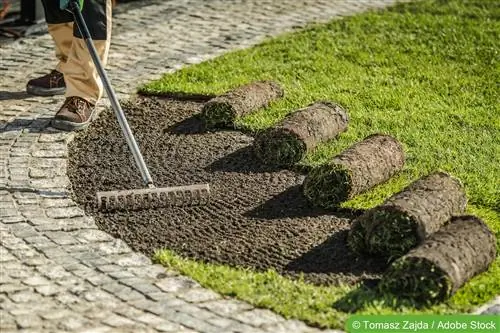- Author admin [email protected].
- Public 2023-12-17 03:39.
- Last modified 2025-01-24 12:45.
Quick and easy to maintain, turf is now used by many gardeners as an alternative when looking for a quick and effective way to lay a lawn. Laying is very easy and convenient compared to methods such as sowing.
The turf can be used for any gate - provided you follow a few instructions and tips. Then the lawn can be a beautiful thing in the long term that is also robust and adaptable. The subsequent care such as mowing and watering goes without saying and can be compared to normal lawn.
Tools and preparation for laying turf
First of all, all necessary tools and machines that loosen the soil must be provided. Only then can laying the lawn begin. In many cases an old lawn is still present. This should be removed first. A so-called sod cutter is particularly suitable for this. Tools and equipment can be borrowed from appropriate hardware stores.
As soon as the ground is freed from the old lawn, it loosens up. A milling machine is ideal for this. This works very effectively and helps get the job done quickly and easily. This is particularly helpful for large areas that have never been planted with lawn. It is important that the floor is not wet or loose during this process. An acceptable result can only be achieved under dry conditions. Afterwards, filing is used to smooth out any unevenness. Disturbing stones or isolated roots should also be removed. Heating the ground is important because otherwise water quickly accumulates, which waters down the lawn.
Further steps when laying finished lawn
The rolling then takes place. The loose soil is pressed down using a roller. A lawn starter fertilizer can be used to support this, which stimulates the soil to grow and thus creates a more beautiful lawn. The soil should not be too sandy, but not clayey either. This way too, wetness would stare at each other. In many cases the existing soil still needs to be enriched with topsoil.
The basis: the soil
A loosened soil has the right structure to start laying the lawn. First, a straight spot in the ground should be chosen as the starting point. Then the loosening is done with a rake. The area is processed lane by lane so that all traces of people and machines are removed. If laying is to be done on a hot summer day, watering breaks must be planned after the first 30 m². It is also important to take the lawn into consideration, because if it is exposed to hot temperatures for too long, sweating can occur, which in turn can cause the roots to die.
When digging the soil, you should definitely test the soil quality. As soon as the soil is too heavy, it needs to be loosened. If the ground is too wet, filling it with sand can help.
Finally
A final work consists of rolling the surface again. This connects the lawn and soil together. This should be done especially in the first three weeks after laying. The roots have then grown into the ground and the turf is very well anchored. At the same time, the lawn must be kept sufficiently wet and moist. If the installation is to take place in midsummer, watering must be carried out up to three times a day. Watering must also be carried out during the busy midday period, otherwise growth will not work. However, after three weeks, watering can be stopped during the lunch break, as watering in the morning and evening is sufficient. Then the motto is: rare and intense is better than often and only light. Watering should be done regularly once or twice a week. The climatic conditions should always be kept in mind. As a rule, 15 to 20 liters of water per square meter are necessary.
Conclusion for laying finished lawn
Precise planning of the laying is important. Knowing the dimensions of the area is crucial. Then you should choose the gardening company that suits you best. Ordering is then easy. It is also important to have support from employees so that the right selection is made. A ready-made lawn is a fresh product that is cut and rolled up directly before delivery. Storing the lawn before laying should not take too long either. If pressure points arise, drying out can occur. As a rule, you can expect around 36 hours that a lawn can lie before it should be laid.
Many people today choose a finished lawn for their garden. Then the strips that were previously cut must also be placed directly next to each other. This is the only way they can grow together unhindered. Each strip must be pressed into place immediately after laying. When cutting, curves and corners can be incorporated in advance. The newly laid area should not be walked on afterwards.
Things worth knowing about soil preparation for turf coming soon
Rolled turf is easy to maintain and looks freshly green right from the start. However, before you can actually lay the rolled turf, you must prepare the ground on which the rolled turf will be installed.
- First of all, you should remove any unevenness. This includes, above all, the removal of stones and roots in the ground.
- The existing weeds must also be removed in order to obtain an optimal result.
- The soil should also be loosened before laying the turf. This can be achieved by digging.
- Loosing the soil is easier with a so-called tiller.
- You should also pay attention to the condition of the soil. If it is too sandy, too clayey or too heavy, you have to take action against it.
If the soil is very sandy, it can be enriched. All types of topsoil or bark humus are particularly suitable for this. However, if the soil is very heavy and clayey, you should mix it with sand. This means no waterlogging can form, which in turn would be harmful to the turf.
Only when these steps have been successfully completed can you begin to level the entire area for the turf with a lawn roller. This is necessary so that the lawn can then lie particularly straight and tidy. You can usually rent the lawn roller from the supplier of the turf or you can get it free of charge anyway. Some negotiating skills are required here.
The ideal time to plant a lawn
A lawn can be planted at any time apart from the winter months, but spring is best suited for this because then the blades of grass have enough time to grow and form strong roots until the next winter. However, if green manure has been previously applied, sowing does not take place until late summer.
Soil preparation
The first step in creating a lawn is to remove stones, weeds, roots and other foreign objects from the soil. The entire soil is then dug up at least 20 centimeters to loosen it up. For small lawns, a spade is sufficient; for larger areas, a milling machine or plow can be rented from a hardware store. The soil is roughly smoothed with a rake, then the surface is completely leveled with a roller. The soil should then have a few weeks to settle. A starter fertilizer ensures that the new lawn is supplied with all the necessary nutrients during the growing season. If the lawn is to be sown later, green manure can also be applied to improve the soil. Plants likeare suitable for this
- Lupine
- Alfalfa
- Phacelia
Sinks and holes in the lawn are extremely difficult to fix afterwards and are very annoying. It therefore makes sense to allow enough time to prepare the ground for leveling the area and to proceed carefully. Cords that are stretched between stakes on the sides of the lawn and aligned with a spirit level are helpful for orientation.
Creating a new lawn
A new lawn is best sown on a day with cloudy skies because then the seeds do not dry out as easily. The soil is then lightly raked up before the seeds are scattered. In order to distribute the seeds as evenly as possible, it is recommended to use a spreader with which one half of the seeds is applied lengthwise and the other half crosswise. Finally, the seeds are lightly pressed down with a roller or, on smaller areas, with a rake so that they are not blown away. Afterwards, water well and make sure that the soil remains evenly moist in the following weeks.
Laying turf correctly
Rolled turf dries out very quickly, so it should be laid as quickly as possible after purchase. It is laid in long strips in which the joints should be slightly offset, like in masonry. After all the strips have been laid, it is pressed down with a roller and then watered until the water has penetrated to the roots. Even a turf that is immediately green should not be walked on straight away. It should have at least three weeks to form roots into the soil below.
Basically, however, you should find out for yourself what the overall nature of the soil is like in the respective region and whether there are any special features that need to be taken into account. A detailed consultation with the dealer who sells the turf will also provide information about this.






